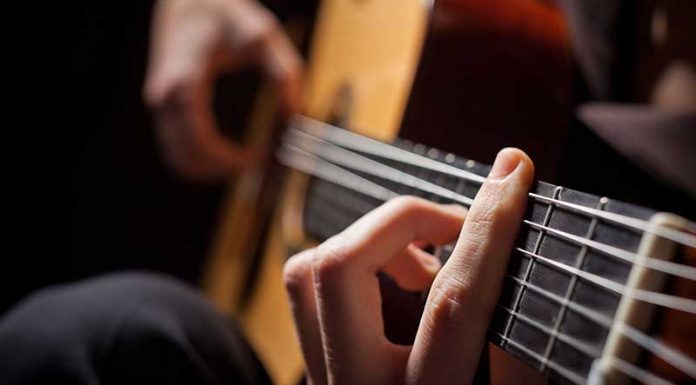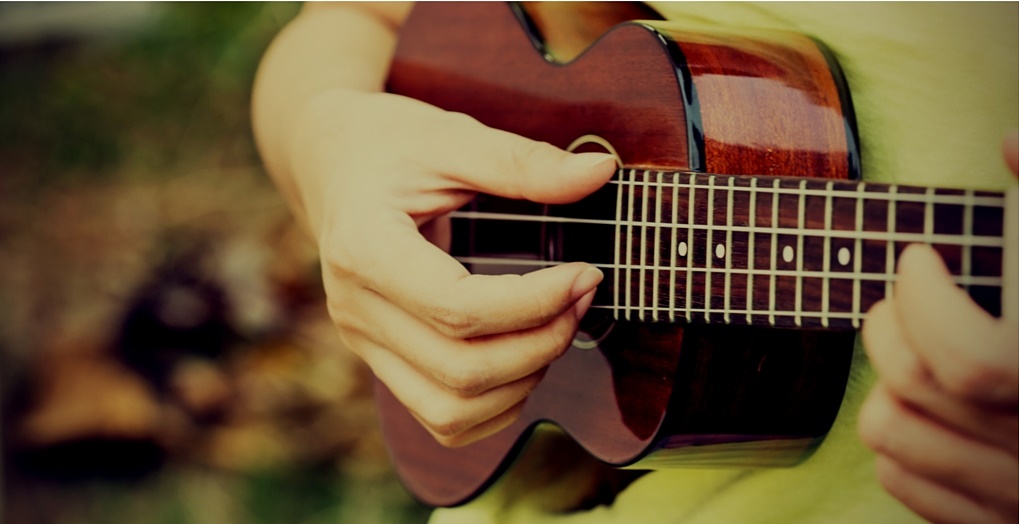A classical guitar is a unique instrument in that it can be fun to play and learn when you get into the world of guitars. However, not all guitars like these are alike. You have to look carefully when finding the best beginner classical guitar that you can play with.
No time to read? Check out Coustii's Top Pics:
Best Guitar Type | Price | Rating |
|---|---|---|
$$ | ||
$$ | ||
$ | ||
Epiphone Pro-1 Acoustic (Editor's Choice) | $$ |
What makes a good classical guitar?
Before you can get a good classical guitar for your desire, you need to think carefully about what such a guitar like this is all about. A classical guitar is specifically a model that is acoustic and made of wood. It also has nylon strings instead of metal ones.
Take a look at the image below to get your bearings on the different parts of an acoustic guitar.

A classical guitar has twelve frets on the body and will be held on the left leg for the hand to be at the back of the sound hole. This is a different type of guitar to play as it can create a more unique acoustic sound. This instrument that can be played fast or slow and can also be used when playing an extended variety of appealing tunes.
The nylon strings are especially worthwhile as they are easier on your fingers and won’t cause blisters or other bothersome pains. This in turn ensures that you can enjoy a great routine when playing the guitar without being bothered by far too much while playing.
Watch out for the tension on the strings to see that it all works properly. The strings use a substantially lower tension level than what you’d get out of another option. A classical guitar typically uses a tension of 75 to 90 pounds.
Meanwhile, a steel-stringed guitar will feature a 150 to 200 pound tension rating. Therefore, the classical guitar should be easier for beginners to play with. Still, you must compare options with one another to find the best beginner classical guitar that you can use.
What size should I get?
A typical classical guitar will be a smaller in size than that of a traditional electric or acoustic guitar. However, you might want to look around to see how big your guitar is before buying one. A typical classical guitar has scales that are about 25 inches in length on average.
The overall length of the guitar is about 40 inches in most cases. This is a basic standard that has been used since the instrument was first introduced, but some companies tend to sell options that are a little smaller or larger. You have to see that whatever guitar you are holding is easy to carry around.
The size of the guitar can also heavily influence the acoustic sounds that come out of it. The resonance frequencies used on a guitar can be adjusted substantially if you have a smaller or larger model. Specifically, a larger guitar will typically feature deeper tones when played properly. The larger sound hole on a bigger model will especially make it easier for sounds to be played properly.
What should I know about the fretboard on a classical guitar?
The fretboard on your classical guitar should be made with a material that is easy to handle and will carry sound well. A rosewood model is always a good option as it creates warmer tones without sounding too rough. Rosewood is especially effective in terms of tuning as it ensures that the guitar will stay active and intact.
Ebony materials will especially be appropriate for your needs. It can help you to create a stable and dense sound. It is also a more durable type of wood to use on the fretboard and even the finger board.
A catalpa back will especially be ideal to have as it will keep a strong setup running while playing the richest possible sounds. This can add a better tone that may add a nicer tone.
Cedar is also used in some fretboards. Cedar is popular for this and other parts of a guitar because it offers a detailed sign that is easier to play with and can create a more intense look. Cedar also adds to the sustain and clarity on the guitar while also keeping any bass sounds vibrant and easy to hear. The cedar wood also allows for sounds to be projected clearly and cleanly creating a more intense sound that you will enjoy hearing.
Plywood or Solid Wood?
There are normally plywood and solid wood materials used in typical classical guitars. A plywood material features a series of wooden layers that have been properly glued together. The top material features a finely made wooden surface while the lower layers are made with some weaker materials instead. However, this all creates a sturdy body.
While a plywood material can be attractive, its notes are not going to be as resonant as they can be with a solid wood material. A solid wood guitar is instead made with one simple wood material that doesn’t require any extra adhesives.
A solid board is also more flexible and can handle vibrations from the strings quite well. The lack of layers and adhesives especially ensures that the guitar will start sounding perfect. You must see when getting this ready that you have a model that is especially thick enough with fewer layers to ensure you’ll have a model that is built the right way and is easy to prepare.
What do I look for in the saddle and nut?
The saddle and nut features on the classical guitar should be made with a bone material. The problem with plastic materials is that while they might be easy to prepare and play with, they can break apart easily and may not do all that well with carrying sounds. The saddle and nut must instead be made of a bone material that will last longer.
This material, which is typically placed around the very top of the neck, needs a bone surface to make it easier to handle vibrations. When used right, it will be easier for the guitar to keep sounds running as well as possible.
When used right, the notes played by the guitar will come out as clearly as possible. Bone also responds to vibrations at a better rate as it can handle even the slightest vibrations. Of course, you can always stop the vibrations on your own and the bone saddle and nut will stop the sounds quickly without any rough effects in the way. This in turn makes it easier for the guitar to be played.
Yamaha C40 GigMaker
The Yamaha C40 GigMaker is a classical acoustic guitar that features Japanese rosewood materials on its body, particularly the finger board. It also uses nineteen frets for a variety of sounds. Indonesian mahogany is used on the back and sides to add a beautiful look while supporting rich tones.
At only seven pounds, this beginner classical guitar is also easy to carry and play with while the body can be easily placed on one’s knee. Chrome tuners also help to keep the strings strung up the right way while also adding a bit of a flashy and classic look to the Yamaha C40 guitar.
Pyle PGA32RBR
The Pyle PGA32RBR is a classical guitar that can handle electric signals but it works best for those who want to play acoustic. The wooden body is made with one piece to keep the vibrations in check while ensuring the sounds are pure.
A rosewood bridge and chrome tuning pegs are especially easy to handle. This is especially easy to carry as it is just five pounds in weight. You can use the built-in preamplifier if you want to play electric, but this beginner classical guitar can be plugged into a speaker for an acoustic option.
Stagg C530 3/4
The Stagg C530 3/4-Size Nylon String Classical Guitar nylon string guitar is a classical guitar that uses a basswood body all around while the maple bridge and finger board are made with dense maple woods. The mahogany neck will take in dense sounds and will prepare only the finest bass effects no matter how deep they are. This is another very lightweight model at four pounds.
The painting on the guitar adds a little flair while the wood material uses a single block without using adhesives. Plus, you can choose from a variety of color options. The glossy body will especially help you look great as you are learning to play with the classical guitar.
The mahogany and neck materials are especially designed to create a thicker look that is easier to play with. The sound hole is also adorned with a fine black and white paint effect but it will not impact how the guitar handles the vibrations that it takes in.
Epiphone Pro-1
The Epiphone Pro-1 is a nylon string classical guitar that features a rosewood finger board with larger frets to help beginners find the right notes. The glossy finish creates a solid look similar to what a plywood model would have but it is still made with a single-layer solid wood body to keep vibrations in check.
Whether your an experienced guitarist and looking to branch out to the classical guitar, or are a beginner and looking for a good git to get you started, you can find a quality instrument in one of the four classical guitars for beginners.













